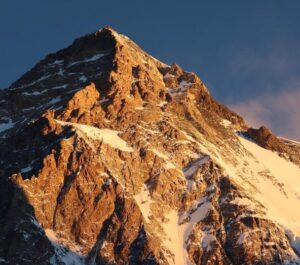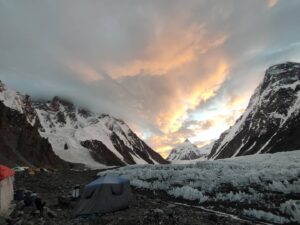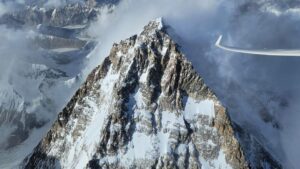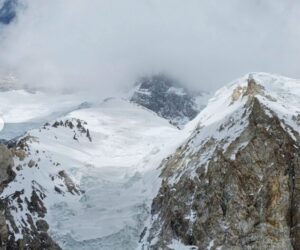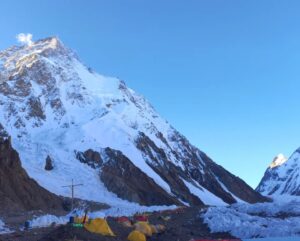At roughly 2:30 am on July 27, a long line of climbers moved slowly above 8,000m on K2, the second-highest mountain in the world and one of the most dangerous. It was dark as they navigated the Bottleneck and the hazardous traverse below the Great Serac. They were focused on their goals. Some were pursuing records. Most knew that they would have to summit that day or go home. Their expeditions wrapped up at the end of the month.
Expedition leaders, coordinating the summit push from Base Camp, started receiving reports of avalanches, and then an accident. Soon after, triumphant summit announcements drowned out the concern. Kristin Harila of Norway and Tenjen Sherpa Lama were among the first to reach the top. A large sherpa team, which helped fix ropes on the upper sections, supported them. Other climbers followed closely behind.

Crowds head to the summit of K2. Photo: Lakpa Sherpa/8K Expeditions
Later, members from other teams also summited: Imagine Nepal, Seven Summit Club, EliteExped, 8K Expeditions/Summit Karakoram, and possibly climbers outfitted by smaller companies.
It was eventually confirmed that a Pakistani porter, Muhammad Hassan, had died. Information about his death remained sketchy. When we started asking around, we received few answers, little concrete information, and several contradictory statements, especially around three issues: 1. How bad were conditions on the mountain, in particular, regarding avalanches? 2. When and why did the accident happen and how did Hassan die? 3. What did nearby climbers do to help?
What was Hassan doing during the summit push?
Hassan was an employee of Lela Peak Expedition. Alex Abramov’s Seven Summit Club assigned him to assist the rope fixers during the summit push.
“Before the summit push, all companies provide [workers] to join the rope-fixing team,” Abramov told ExplorersWeb. “We contributed with three Pakistani HAPs. Hassan was one of them.
“We don’t know what really happened because he was ahead of our members and sherpa group,” Abramov added. “Members only saw that something happened at the ropes in the traverse.”

Mohammad Hassan. Photo: Adventure Alpine Guides
Some climbers, including Lakpa Sherpa of 8K Expeditions and cameraman Philip Flaemig, noted that Hassan was not very experienced and that his equipment was inadequate for a summit push on K2. ExplorersWeb contacted Lela Peak Expeditions for a statement but we are yet to hear back.
Avalanches

Silvia Azdreeva of Bulgaria on K2’s summit on July 27. Photo: Silvia Azdreeva
Silvia Azdreeva of Bulgaria summited K2 that day as a member of the EliteExped team.
“During the summit push, there were five avalanches next to us below the Bottleneck,” Azdreeva said. “One of them hit some of us on the way up. Luckily, we weren’t injured and we managed to dig out of the snow. We debated if we would continue or give up…
“[Then later,] a person died in front of my eyes. One moment he was alive and then on the way back we had to jump over his corpse on the ice edge that we were passing.”
Azdreeva justified continuing their push, saying that on K2, “There is no one to save you so quickly, you have to wait for days.”
EliteExped confirmed that Pasang Ngima Sherpa and Azdreeva summited at 12:53 pm local time.

Climbers on the ropes on K2 in bad weather. Photo: Allie Pepper
American climber Lucy Westlake told ExplorersWeb that one of the avalanches fell right on her.
“At around 2:30 am, I was in an avalanche (luckily just thick powder) below the place where the Pakistani climber had fallen. The first avalanche triggered a second avalanche below us, but we were only hit by the first one,” Westlake said.
Nobody in Westlake’s group was hurt, but they knew things would have been different if the avalanche had been bigger, so they decided to turn back.

Lucy Westlake (left) and a sherpa guide, ready to depart from Camp 3. Photo: Lucy Westlake
How did the accident happen?
On this point, reports remain wildly contradictory. “Hassan fell down and broke his O2 mask,” Lakpa Sherpa, who was in Base Camp, told ExplorersWeb. “Hassan fell and hit a rock,” Mingma G said, also from Base Camp. “He fell in a crevasse,” Lucy Westlake said.
Wilhem Steindl, climbing with Furtenbach Adventures, heard that the porter had died in an avalanche.

Headlamps mark the way to the traverse above 8,000m on K2. Photo: Lucy Westlake
Eventually, the pieces of the puzzle start to fall into place.
“A Pakistani climber fell and was hanging upside down for over an hour,” climber Allie Pepper said. “They managed to pull him back up. At first, he was alive, but he couldn’t be saved. Then everyone had to step over him to head toward the summit.”
Luis Soriano was in the second Seven Summit Club team, which reached the summit one day later.
“I talked to the sherpa who saw him fall and who helped Hassan back to the traverse,” he told ExplorersWeb. “Apparently, Hassan slipped and fell, and eventually stopped, face down, crying, until someone managed to drag him back to the traverse.”
The sherpa who helped Hassan was Halung Dorchi Sherpa of 8K Expeditions. He later reported back to his expedition leader, Lakpa Sherpa, who confirmed the facts to ExplorersWeb. “Hassan’s O2 mask broke in the fall,” he said. “Halung Dorchi Sherpa and one of Kristin Harila’s camera operators helped Hassan back to the trail.”
The camera operator declined to comment. We have asked Kristin Harila for comment but are yet to hear back.
Lakpa Sherpa also said that, after Hassan was eventually helped back to the trail [but unable to move under his own power], “he suddenly passed away.”
Drone footage suggests otherwise
“Not so suddenly,” said Philip Flaemig, a cameraman working on the mountain for Servus TV. “The porter was still moving three hours after the accident.”
Flaemig was not there, but his drone was. Flaemig was with Wilhem Steindl and team sirdar Mingma Sherpa near the bottom of the Bottleneck at 2:30 am. They were waiting for the rest of their team and for the crowds at the Bottleneck to disperse.
Flaemig recounts what happened:
There was some 30 people at the beginning of the Bottleneck and another big group at the traverse. Then there was a big avalanche crack and suddenly the headlamps were gone in the dust that covered the mountain.
Mingma Sherpa ran away and we all lay flat on the ground. Luckily, nothing else came down, but we were concerned something serious had happened at the Bottleneck. It was scary.
A number of headlamps at the Bottleneck turned and started down. About ten people passed us and said the ropes had been cut.
I suggested, let’s wait, let’s wait. A whole group of headlamps at the traverse stopped and it remained blocked for 90 minutes to two hours. At the time, we didn’t know what was happening. Later, we would find out it was the accident.
The lines of climbers at K2’s traverse. A frame from drone footage by Philip Flaemig for Servus TV
My team eventually decided to go down. I remained where I was, with my camera assistant sherpa, and guide Fernando from Argentina, because I wanted to take a drone shot and I needed to wait until sunrise for it. I waited for two more hours and started to film the group going up and the other group at the traverse. I was cold and my fingers were numb, so when I used my last battery at around 5:30 am, I went all the way down to Base Camp.
The following day, I was copying the material to the computer and someone said, ‘Hey, what’s that?’ Someone was rubbing a man in the snow. There was a man lying right on the trail at the traverse, with some 20 people in front of him and at least 10 more behind. In the video, you could clearly see that the man was moving his leg, so he was clearly alive.
ExplorersWeb has seen the images, shot in daylight, and can confirm that Hassan moves his leg. Because of copyright issues, we can’t share the video, but Flaemig and Servus TV kindly shared some still images.

The situation at the traverse at around 5:30 am. Hassan is located in the circle. A frame from drone footage by Philip Flaemig for Servus TV

A stunning number of climbers at the traverse, in front and behind Hassan, marked with a circle. Seconds later, the drone flew nearer and caught a Pakistani climber rubbing Hassan’s chest, while Hassan was still moving. Frame from drone footage by Philip Flaemig for Servus TV

A close-up shows climbers moving past Hassan. Frame from drone footage by Philip Flaemig for Servus TV.
Flaemig talked extensively with Harila’s camera operator. He confirmed that Hassan’s accident took place at 2:20 am, shortly before the main avalanche that fell at 2:35 am. Flaemig started filming with his drone at 4:30 am when it was still dark and continued until 5:30 am, 20 minutes after sunrise.
Flaemig and Wilhem Steindl collected money for Hassan’s family from their expedition teammates (although none of them were close to the accident or the traverse). After trekking out, they visited Hassan’s widow.
“[She] said it was his first time on the upper slopes of K2,” Flaemig said. “Previously, he had only worked as a porter to Base Camp, but this time he needed to make more money to pay for treatment for his sick mother, who was also at home when I visited.” Hassan also left three small children.
Why was there no rescue attempt?
“I do not know how there was no attempt to rescue him, although he was in a very complex place, right on the trail in the middle of the traverse under the Great Serac,” Luis Soriano said. “People literally had to jump over him on their way to the summit. I passed by that place on the following day and the body was there. A tragedy.”
“There is no rescue team on K2 and the Liaison Officer can do nothing,” Lakpa Sherpa said. “Before his accident, some sherpas [in the rope-fixing team] told him to go back many times, because his climbing equipment and clothes were very poor, but he didn’t listen and followed the other climbers. The weather was very bad and most of the climbers were approaching the summit of K2. I guess, once he got injured, he may not have been able to move…so from the Bottleneck, it’s very difficult to bring him down.”
Asked what could be done for a climber in trouble at K2’s traverse, Lakpa said: “They must give him oxygen first and then mobilize the team to bring him down.”
“If I had known [about] the problems I would have helped,” Lakpa said. “It doesn’t matter which team you are in, but I only got the news once he passed away. However, my team and sherpas still helped him.”
Said Lukas Furtenbach, owner of Furtenbach Adventures: “We would have stopped our summit push and helped, no matter what it takes. Even if it means we have to give up our oxygen supplies and even if it means no summit for all our clients. This is a fundamental part of the pre-summit push briefing I do with all clients. I always prepare them so that if we come across a situation like that, we help. Period.”
How to avoid another tragedy on K2
“Obviously [everyone] must be well equipped and have proper mountaineering safety training. [Climbers] must also be controlled by team leaders to minimize the risk and follow guidelines. Mostly, Pakistan’s HAPs never listen to the team leader or manager because of a lack of knowledge,” Lakpa Sherpa said.
“Expedition operators have to take responsibility for their staff and the staff they hire temporarily, for example for rope-fixing. Of course, it should be a no-brainer to help other climbers in an emergency situation. No matter what the cost, no matter if this person is a client or staff. And if a staff member dies, the family has to be supported,” Furtenbach said.



